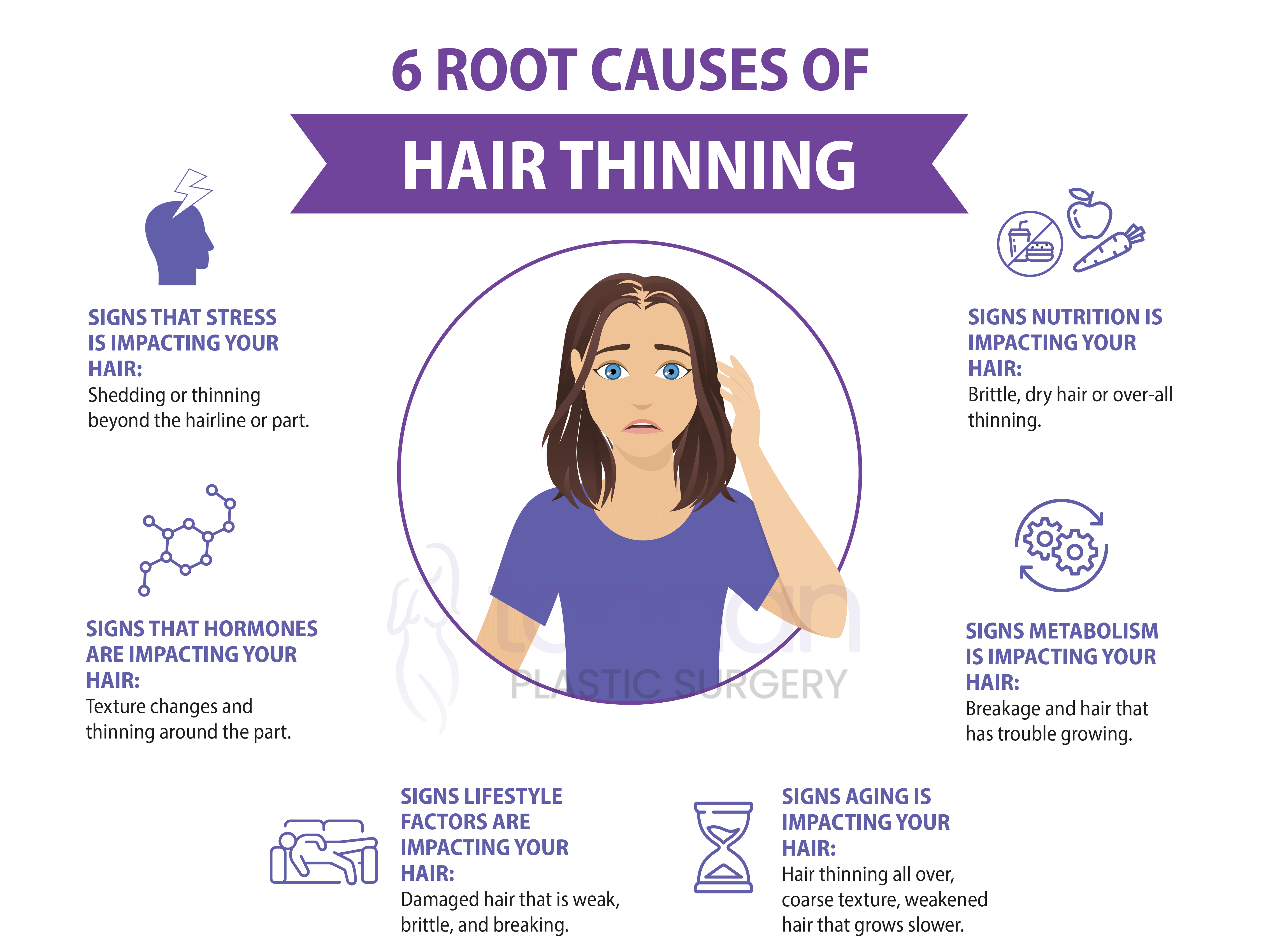GLP-1 Medications, Hormonal Imbalance & Hair Loss: What You Need to Know
Noticing more hair in your brush or shower drain lately? This is more common than you think, and it can feel scary when your hair doesn’t seem as full or healthy as it once was. While genetics and aging play a role, there are other important factors that lead to hair loss. Let’s look closer at two of those: changes in hormones (think menopause) and popular medications like GLP-1s (such as semaglutide or tirzepatide).
How Do Hormone Changes Contribute to Hair Loss?
If you’re in your 40s and 50s and starting to notice changes in your body — your skin feels different, your sleep isn’t what it used to be, your mood shifts more often, and your hair seems thinner — you’re likely entering perimenopause or menopause. This phase can be confusing and sometimes frustrating, especially when one of the most visible changes shows up as hair loss.
So, what’s really going on?
- It starts with hormone changes. During perimenopause, your levels of estrogen and progesterone begin to naturally decline. These hormones help keep your hair strong, full, and growing at a healthy rate.
- Your hair follicles react. As these hormones drop, hair follicles start to shrink, and the hair that grows becomes finer and more brittle. You may also notice your hair doesn’t grow as fast as it used to.
- Your scalp can change too. Hormonal shifts can make your scalp either oilier or drier than usual. Neither condition is ideal for healthy hair growth, and both can contribute to ongoing hair loss.
- It’s not just physical — it’s emotional too. Seeing your hair thin or fall out can be upsetting. After all, it’s something you can see happening right in front of you, and it can take a toll on your confidence.The good news?
Hair loss during perimenopause is common, and understanding the role hormones play is the first step toward managing it. With the right care and support, you can create a healthier environment for your hair and scalp as your body transitions.
How Do GLP-1 Weight Loss Medications Contribute to Hair Loss?
If you’re taking GLP-1 weight loss medications you may have started noticing more strands of hair in your brush or shower drain. Some people experience hair loss while on these medications — but it’s not usually the medication itself that is to blame.
Here’s what’s really happening:
- It’s about rapid weight loss, not the drug itself. GLP-1 medications help you lose weight by controlling appetite and slowing digestion. When weight loss happens quickly, your body goes through major changes that can temporarily affect your hair growth cycle.
- Nutritional shifts play a big role. As you eat less or change your diet, your body might not get enough essential nutrients — like protein, iron, and certain vitamins — that support healthy hair. This can trigger hair shedding or temporary hair loss, especially when you are still adjusting to the GLP-1, your newly reduced appetite, and finding a way to make sure you get adequate nutrition on this medication.
- Stress on the body can show up in your hair. Any sudden physical change, including rapid weight loss, can be a form of stress for your body. This can lead to a condition called telogen effluvium, where more hairs than usual enter the shedding phase.
- The good news: it’s usually temporary. Most hair loss from GLP-1 medications is short-term. Once your weight stabilizes and your nutrition improves, your hair growth cycle typically returns to normal.
So, while GLP-1 weight loss medications can be associated with hair loss, it’s really the rapid changes in weight and nutrition that cause the shedding — not the medication itself. Supporting your body with balanced nutrition and patience can help your hair bounce back over time.
How Do You Know The Difference?
It’s normal to lose 50–100 hairs a day. But if you’re noticing:
- Overall thinning, not just a single bald spot
- Widening of your part or thinning at the sides (temples)
- Hair falling out a few months after a big change (like starting a GLP-1 medication, having a baby, or changing hormones like perimenopause)
- Other symptoms like fatigue, mood changes, or irregular cycles happening at the same time
- New hair growth that seems weaker or finer than before
…it may be related to hormonal imbalance, stress, or shifts in nutrient intake. Timing is everything, and collaborating with your health care provider can help you sort out the cause of your hair loss.
When to Talk With Your Provider
If you’re seeing more hair loss than usual, it’s a good idea to schedule a check-in. Your provider can run simple lab tests to look at:
- Thyroid function
- Iron, vitamin D, and other nutrient levels
- Hormonal balance (such as estrogen, progesterone, testosterone, or cortisol)
A Personal Note from Sidnie: The Importance of Women’s Specialty Follow-Up
Because peri-menopause affects various aspects of a woman’s health, it’s crucial to have regular follow-ups with a healthcare provider who specializes in women’s health. A gynecologist or an endocrinologist can provide guidance on managing the hormonal shifts that occur during this phase of life. They may recommend testing to assess hormone levels and help create a tailored treatment plan, including hormone replacement therapy (HRT) or lifestyle changes. Early intervention has been shown to mitigate peri-menopause symptoms, decrease your risk of osteoporosis, minimize hair loss, and support overall well-being.
On a personal note, I recently had a visit with a GYN who specializes in peri-menopause and menopause. She listened to my symptoms and concerns. She did not dismiss what I was saying or the experience I am having with peri-menopause. She made recommendations based on symptomology and she supported her health care decisions with evidence-based research.
For the first time in over a year, I felt like I was being listened to and validated. I was not being bullied into feeling that I needed to “tough it out” like previous generations of women. Being a woman and having health concerns being taken seriously should not be that difficult and you should never be made to feel that your health care concerns are not valid. Meeting with this physician made me realize how important it is to find the RIGHT provider. My advice to you is to listen to your gut and find the right provider for you – do not suffer in silence.
Supporting Hair Growth From the Inside Out*
One supplement we often discuss with patients is Nutrafol. It’s clinically tested and works by addressing multiple factors behind hair thinning—stress, hormones, nutrition, and inflammation.
Here’s how you can build a regimen:
- Nutrafol Core: Options for varying life phases of women, men and even a vegan formulation. This is the foundation formula.
- Boosters for personalization:
- Stress Adaptogen → balances stress hormones
- DHT Inhibitor → supports hormone-related hair loss
- Hairbiotic → supports gut health and nutrient absorption
- Vitamin B-Booster → replenishes key nutrients
Most people start to notice results in about 3–6 months when they stay consistent.
The Takeaway
If you’re experiencing hair loss while on a GLP-1 medication or when postpartum or perimenopause, don’t ignore it—your hair is often a good metric of your overall health. The good news? With the right testing, supportive care with the right provider, and targeted supplements, you can get to the root of the issue and restore both your hair and your confidence.
*These statements have not been evaluated by the Food and Drug Administration and are supplements, not prescriptions designed to treat medical conditions.
Remember, this journey is about making sustainable changes over time. If you need more personalized advice, our all female staff can help to create a personalized treatment plan tailored to your specific needs and goals.
Ready to get started on your journey to a healthier you? Call us today to schedule a consultation (919) 797-0996.
Contributed by Sidnie, Nurse Injector











